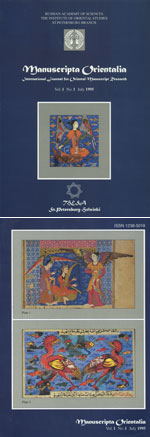|
|
| |

|

|
Vorobyova-Desyatovskaya M. An Unique Manuscript of the “Kāśyapaparivarta-sūtra” in the Manuscript Collection of the St Petersburg Branch of the Institute of Oriental Studies, Russian Academy of Sciences // Manuscripta Orientalia. Vol. 1, No 1, July 1995. Pp. 12-16.
There is a unique Sanskrit manuscript of the Kāśyapaparivarta-sūtra in the collection of the St. Petersburg Branch of the Institute of Oriental Studies which continues to attract the attention of scholars since 1926 when A. von Staël-Holstein published its transliteration. The reason of this unusual interest becomes clear if we take into consideration that the oldest part of this sutra, that is its core, was formed at the earliest stage of development of the Mahāyāna literature (Conze, 1968, p. 302—5; Pāsādika, 1991, p. 59), and that the two most important philosophical schools of Mahāyāna — Mādhyamika and Yogācāra — accepted it as the basic text of their doctrine. On the other hand, the sutra presents particular interest for the study of moral and ethical rules of Mahāyāna on account of the moral code of bodhisattva for first time worked out and formulated in its text. The code was quoted in many other Mahayana texts and held in high respect in Central Asia and the Far East. So far the Tibetan, Mongolian, Khotan-ese and five Chinese translations of the sutra were known. Recently one more translation has been found by scholars.
The facsimile of the manuscript has not yet been published. Its text needs a new reading since it became more legible after the restoration of the manuscript.
The task of describing and publishing this popular text caused us to use a great amount of literature. In this paper we try to connect this text with the history of Central Asiatic Buddhism and Buddhist canon to find the link between the formation of the text and the inner processes in Buddhism in the first centuries A.D. when it overstepped the boundaries of India. The analysis of the Buddhist canonical texts written in different languages (Sanskrit, Tibetan, Chinese, Khotanese) and discovered on the territory of Eastern Turkestan (Xinjiang) and Tun-huang (Gansu), enables us to find the quotations from the Kāśyapaparivarta in several different texts. The character of these quotations seems to clarify the problem of how the main doctrines of Mahāyāna were comprehended in Eastern Turkestan and Tun-Huang as well as their further development.
This paper represents our first attempt to introduce to scholars the facsimile of the manuscript of the Kāśyapaparivarta-sūtra and to investigate it in terms of the above mentioned tasks as well. It should be taken into account that those scholars who dealt with the text, were insisting on the necessity of publishing its facsimile. Some of them, like Dr. Daniel Boucher from the Indiana University (Bloomington), tie their further scholarly research with this publication. The facsimile edition has been prepared by me together with Prof. G. M. Bongard-Levin long time ago. We both hope to publish it in a series of books, attached to the Journal Manuscripta Orientalia as soon as possible.
In the paper we confine ourselves to two problems only: the history of the study of the text and the question of its creation as reflected in the written sources. The solution of the problems seems to be possible due to a series of new studies on the history of Madhyamika school and Nāgārjuna's works. We suppose to touch the problem of the role of the Buddhist teachers of Eastern Turkestan in the transformation of the former text of the sutra. It is known that there was the Central Asian version of the sutra which was used as a basis for the Tibetan and Chinese translations… PDF-files PDF-files
The entire paper
Keywords
Buddhist literature
Kāśyapaparivarta-sūtra
Mahāvyutpatti
Manuscripta Orientalia, selected papers
Nāgārjuna
|
|
|
|
Random news: Announcements |
|
Preliminary defense of the dissertation for the degree of Doctor of Sciences in History by I.V. Bogdanov titled “Epigraphic sources on the socio-political and cultural history of Ancient Egypt: monuments and their fates” will be held on July 8, 2024. |
|
Read more...
|
|
|
|
|

